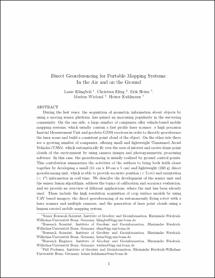Klingbeil, Lasse; Eling, Christian; Heinz, Erik; Wieland, Markus: Direct Georeferencing for Portable Mapping Systems: In the Air and on the Ground. In: Journal of Surveying Engineering143, 4.
Online-Ausgabe in bonndoc: https://hdl.handle.net/20.500.11811/4810
Online-Ausgabe in bonndoc: https://hdl.handle.net/20.500.11811/4810
@article{handle:20.500.11811/4810,
author = {{Lasse Klingbeil} and {Christian Eling} and {Erik Heinz} and {Markus Wieland}},
title = {Direct Georeferencing for Portable Mapping Systems: In the Air and on the Ground},
publisher = {American Society of Civil Engineers, Surveying and Mapping Division},
year = 2017,
month = nov,
journal = {Journal of Surveying Engineering},
volume = 143,
number = 4,
note = {During the last few years, the acquisition of geometric information about objects by using a moving sensor platform has gained increasing popularity in the surveying community. A large number of companies offer vehicle-based mobile mapping systems, which usually contain a fast profile laser scanner, a high-precision inertial measurement unit, and geodetic global navigation satellite system (GNSS) receivers to directly georeference the laser scans and build a consistent point cloud of the object. In contrast, there is a growing number of companies offering small and lightweight unmanned aerial vehicles (UAVs), which automatically fly over the area of interest and create dense point clouds of the environment by using camera images and photogrammetric-processing software. In this case, the georeferencing is usually realized by ground control points. This contribution summarizes activities performed by the authors to bring both fields closer together by developing a small (11 × 10 × 5 cm) and lightweight (240-g) direct-georeferencing unit, which is able to provide accurate position (<5 cm) and orientation (<1°) information in real time. The authors describe the development of the sensor unit and the sensor-fusion algorithms, address the topics of calibration and accuracy evaluation, and provide an overview of different applications in which the unit has been already used. These include the high-resolution acquisition of crop-surface models by using UAV-based imagery, the direct georeferencing of an autonomously flying robot with a laser scanner and multiple cameras, and the generation of laser point clouds using a human-carried mobile mapping system.},
url = {https://hdl.handle.net/20.500.11811/4810}
}
author = {{Lasse Klingbeil} and {Christian Eling} and {Erik Heinz} and {Markus Wieland}},
title = {Direct Georeferencing for Portable Mapping Systems: In the Air and on the Ground},
publisher = {American Society of Civil Engineers, Surveying and Mapping Division},
year = 2017,
month = nov,
journal = {Journal of Surveying Engineering},
volume = 143,
number = 4,
note = {During the last few years, the acquisition of geometric information about objects by using a moving sensor platform has gained increasing popularity in the surveying community. A large number of companies offer vehicle-based mobile mapping systems, which usually contain a fast profile laser scanner, a high-precision inertial measurement unit, and geodetic global navigation satellite system (GNSS) receivers to directly georeference the laser scans and build a consistent point cloud of the object. In contrast, there is a growing number of companies offering small and lightweight unmanned aerial vehicles (UAVs), which automatically fly over the area of interest and create dense point clouds of the environment by using camera images and photogrammetric-processing software. In this case, the georeferencing is usually realized by ground control points. This contribution summarizes activities performed by the authors to bring both fields closer together by developing a small (11 × 10 × 5 cm) and lightweight (240-g) direct-georeferencing unit, which is able to provide accurate position (<5 cm) and orientation (<1°) information in real time. The authors describe the development of the sensor unit and the sensor-fusion algorithms, address the topics of calibration and accuracy evaluation, and provide an overview of different applications in which the unit has been already used. These include the high-resolution acquisition of crop-surface models by using UAV-based imagery, the direct georeferencing of an autonomously flying robot with a laser scanner and multiple cameras, and the generation of laser point clouds using a human-carried mobile mapping system.},
url = {https://hdl.handle.net/20.500.11811/4810}
}






